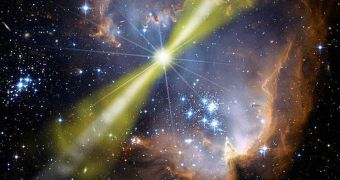About 450 million years ago, when the Ordovician-Silurian extinction event took place, some 60 percent of all marine invertebrates died out. Researchers analyzing why the phenomenon took place now say that gamma-ray bursts from a nearby star may have had something to do with this.
Scientists agree that some of the Earth-bound driving agents behind the extinction included the lowering of global sea levels (brought on by the separation of the Gondwana continent), and glacially driven cooling. The Ordovician extinction took place in two phases.
About a million years passed between the first and the second phases, and this made the event the second-most devastating in history. It was only exceeded in scope and intensity by the Permian-Triassic extinction event. When it happened, all of Earth's life was concentrated in oceans.
Astronomers now say that it's entirely possible for a near star to have contributed to the extinction, through the release of a massive gamma-ray burst (GRB). This flash of intensely-energetic light could have hit our planet head-on.
The chances of this happening are fairly remote, since the progenitor star would have had to be placed in a very specific position. Until now, experts had no way of determining whether a potential star existed in such a configuration or not, but a recent study resolved this issue.
The research was conducted because the second phase of the Ordovician extinction defies explanation. Paleoclimatologists determined some time ago that the first phase was caused by carbon dioxide and volcanic debris emissions, but no plausible explanation exists for the second phase.
A hypernova explosion – a stellar explosion more powerful than even a supernova – may have occurred about 1,000 light-years away, which is basically in our cosmic backyard. Astrophysicists agree that – were a GRB from such an explosion to hit Earth – the consequences would have been devastating.
One of the methods scientists will use to test this hypothesis is to browse through data that will be sent back to Earth by the Gaia Star-Mapper, a spacecraft the European Space Agency (ESA) plans to launch in 2013.
One of the main objectives the mission has is to map the position of all globular clusters in the Milky Way. Since a hypernova explosion could have only originated in a large cluster star, the maps will allow experts to calculate the locations of all clusters about 450 million years ago, io9 reports.

 14 DAY TRIAL //
14 DAY TRIAL //